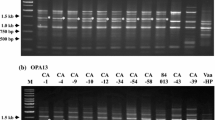Abstract
Chinese cabbage yellows caused by Verticillium dahliae and V. longisporum is one of the most economically important diseases in Japan. Verticillium isolates from infected Chinese cabbage in Japan were identified as V. dahliae and V. longisporum based on morphological characteristics and newly developed molecular genotyping methods using group I intron of 18S rDNA, mitochondrial-SSU rDNA and cob gene. Although the two species were equally virulent to Chinese cabbage in the greenhouse, V. longisporum was more virulent in the field compared with V. dahliae. Among the 67 Verticillium isolates from Chinese cabbage, 53 were V. longisporum and considered to be the major pathogen. The isolation frequency of V. longisporum was 98 % in Ibaraki and eastern Gunma where Chinese cabbage was cropped from autumn to winter. In contrast, the frequency was 48 % in Nagano and north to west Gunma where the plant was cropped in cool summer and highland conditions and the rests were V. dahliae. This is the first report to show the different geographical distribution of V. longisporum and V. dahliae in Chinese cabbage production area of Japan.



Similar content being viewed by others
References
Anonymous (2000) Common names of plant diseases in Japan. (in Japanese) Japan Plant Protect Assoc, Tokyo, p 857
Banno S, Saito H, Sakai H, Urushibara T, Ikeda K, Kabe T, Kemmochi I, Fujimura M (2011) Quantitative nested real-time PCR detection of Verticillium longisporum and V. dahliae in the soil of cabbage fields. J Gen Plant Pathol 77:282–291
Clarkson J, Whipps J (2002) Control of sclerotial pathogens in horticulture. Pestic Outlook 13:97–101
Eckert JW (1962) Fungistatic and phytotoxic properties of some derivatives of nitrobenzene. Phytopathology 52:642–649
Fahleson J, Hu Q, Dixelius C (2004) Phylogenetic analysis of Verticillium species based on nuclear and mitochondrial sequences. Arch Microbiol 181:435–442
Horiuchi S, Hagiwara H, Takeuchi S (1990) Host specificity of isolates of Verticillium dahliae towards cruciferous and solanaceous hosts. In: Hornby D (ed) Biological control of soil-borne plant pathogens. CAB International, Wallingford, pp 285–298
Howell CR (1970) Differential enzyme synthesis by haploid and diploid forms of Verticillium albo-atrum. Phytopathology 60:488–490
Iijima T (1981) Species name of domestic Verticillium in Japan (Abstract in Japanese). Ann Phytopathol Soc Jpn 47:131
Karapapa VK, Typas MA (2001) Molecular characterization of the host-adapted pathogen Verticillium longisporum on the basis of a group-I intron found in the nuclear SSU-rRNA gene. Curr Microbiol 42:217–224
Karapapa VK, Bainbridge BW, Heale JB (1997) Morphological and molecular characterization of Verticillium longisporum comb. nov., pathogenic to oilseed rape. Mycol Res 101:1281–1294
Kemmochi I, Sakai H, Shiraishi T (1999) Pathogenicity of Verticillium longisporum and Verticillium dahliae isolated from cabbage (Brassica oleracea L. var. capitata) to some crops. (in Japanese) Ann Rep Kanto-Tosan Plant Prot 46:31–34
Koike M, Fujita M, Nagao H, Ohshima S (1996) Random amplified polymorphic DNA analysis of Japanese isolates of Verticillium dahliae and V. albo-atrum. Plant Dis 80:1224–1227
Li KN, Rouse DI, German TL (1994) PCR primers that allow intergeneric differentiation of ascomycetes and their application to Verticillium spp. Appl Environ Microbiol 60:4324–4331
Ramchiary N, Lim YP (2011) Genetics of Brassica rapa L. In: Schmidt R, Bancroft I (eds) Genetics and genomics of the Brassicaceae. Springer, New York, pp 215–260
Sakai H, Shiraishi T, Suwa S, Kemmochi I, Ohtsuka K, Urushibara T (1998) The occurrence of Verticillium wilt of cabbage in Gunma Prefecture and the pathogenic group of its pathogens (Abstract in Japanese). Ann Phytopathol Soc Jpn 64:331
Sakai H, Shiraishi T, Urushibara T (2001) The occurrence of Verticillium wilt of cabbage by Verticillium longisporum and V. dahliae (Abstract in Japanese). Jpn J Phytopathol 67:160–161
Watanabe T, Ozawa M, Sakai R (1973) A new disease of Chinese cabbage caused by Verticillium albo-atrum and some factors related to the incidence of the disease. Ann Phytopathol Soc Jpn 39:344–350
Acknowledgments
This work was supported in part by a grant of Strategic Research Foundation Grant-aided Project for Private Universities from the Ministry of Education, Culture, Sports, Science, and Technology of Japan. We thank Dr. Jun Takeuchi (Tokyo Metropolitan Center for Agriculture, Forestry and Fisheries on Outlying Islands Hachijo Branch Office) for providing isolates BP-1, -2, and -3.
Author information
Authors and Affiliations
Corresponding author
Electronic supplementary material
Below is the link to the electronic supplementary material.
Rights and permissions
About this article
Cite this article
Ikeda, K., Banno, S., Watanabe, K. et al. Association of Verticillium dahliae and Verticillium longisporum with Chinese cabbage yellows and their distribution in the main production areas of Japan. J Gen Plant Pathol 78, 331–337 (2012). https://doi.org/10.1007/s10327-012-0400-z
Received:
Accepted:
Published:
Issue Date:
DOI: https://doi.org/10.1007/s10327-012-0400-z




